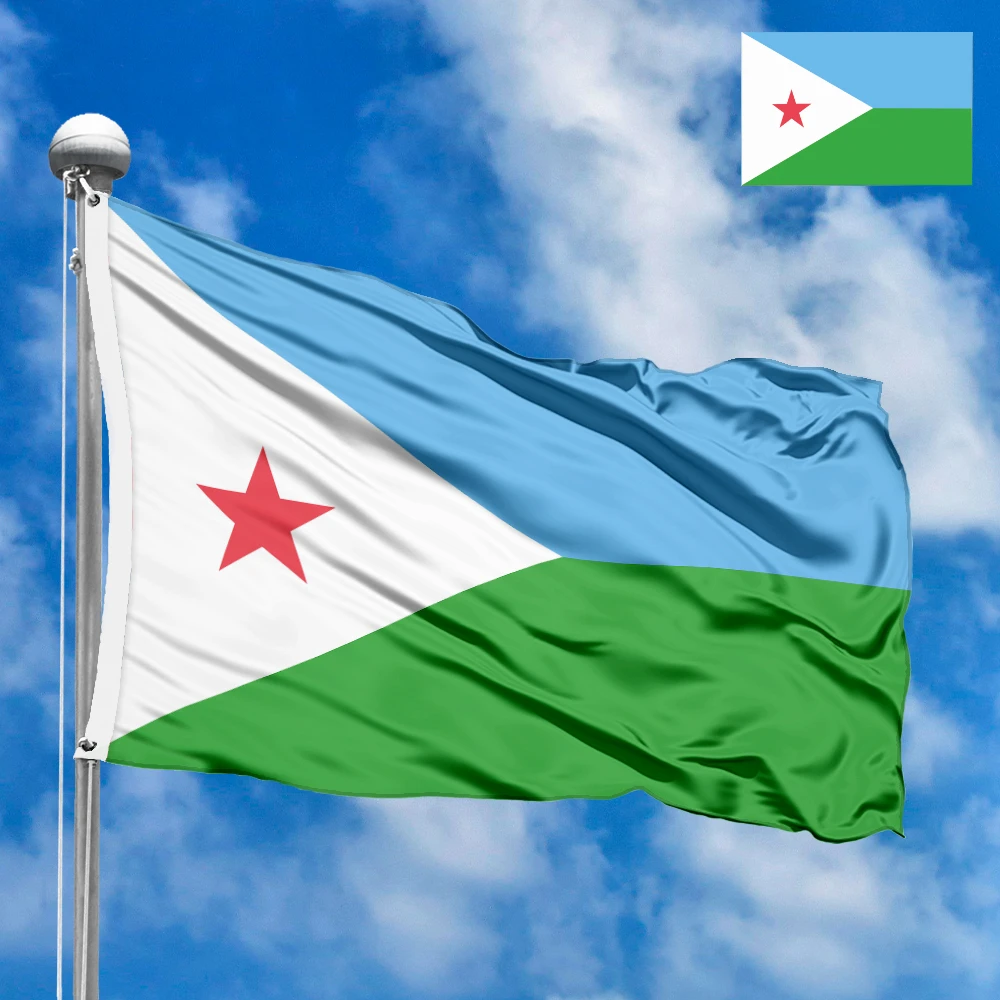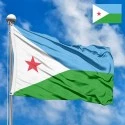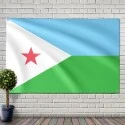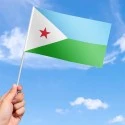The national flag of Djibouti is a striking and meaningful symbol that encapsulates the nation's journey towards independence, its rich cultural tapestry, and its aspirations for unity and peace. Adopted on June 27, 1977, the day the country gained independence from France, the flag is a powerful visual representation of the Republic of Djibouti's identity, nestled in the strategic Horn of Africa. Its design, though seemingly simple, is imbued with profound symbolism reflecting the land, the sea, the people, and their collective future.
Design and Symbolism: A Harmony of Elements
The flag of Djibouti features two equal horizontal bands of light blue (top) and light green (bottom), with a white isosceles triangle on the hoist side. Within this white triangle, a red five-pointed star is centrally placed. Each color and element on the flag carries a specific and deeply rooted meaning, representing different facets of the Djiboutian nation:
-
Light Blue (Top Band): The upper light blue horizontal band symbolizes the sky and the sea, particularly the Indian Ocean and the Gulf of Aden that border Djibouti. This color also broadly represents peace and the desire for tranquility within the nation and with its neighbors. It evokes the clear skies and the vast waters that have historically connected Djibouti to the wider world through trade and maritime activities. It signifies the aspirations for serenity and stability, crucial for a country in a geopolitically sensitive region.
-
Light Green (Bottom Band): The lower light green horizontal band represents the earth and prosperity. Specifically, it alludes to the few areas of fertile land and the hope for agricultural development within the otherwise arid landscape of Djibouti. More broadly, it symbolizes life, growth, and the country's economic potential. It acknowledges the nomadic heritage and the connection to the land that sustains the Djiboutian people, suggesting a future of sustained development and well-being.
-
White Isosceles Triangle: The prominent white isosceles triangle on the hoist side of the flag stands for peace and equality. White, universally recognized as a color of purity and peace, in this context specifically signifies the enduring commitment of the Djiboutian people to peace both internally and externally. Its triangular shape, pointing towards the fly, suggests a dynamic movement forward, emphasizing progress and unity. It also implies the equal standing of all ethnic groups within the nation.
-
Red Five-Pointed Star: Positioned centrally within the white triangle is a vibrant red five-pointed star. This star is the most powerful and significant symbol on the flag, representing unity and the blood shed by the martyrs who fought for the nation's independence. Red signifies sacrifice, valor, and the struggle for freedom. The five points of the star are often interpreted as representing the five principal regions inhabited by the Somali and Afar ethnic groups (Djibouti, Dire Dawa in Ethiopia, northern Somalia, the Somali region of Ethiopia, and northern Kenya), thus symbolizing the unity of these communities within the nation and the broader region. It acts as a beacon of solidarity and a reminder of the nation's shared identity forged through collective struggle.
Together, these elements form a cohesive visual narrative that speaks to Djibouti's past struggles, its present identity forged in unity, and its future aspirations for peace, prosperity, and continued national cohesion.
Dimensions and Proportions:
The official proportions of the Flag of Djibouti are a width-to-length ratio of 2:3. This is a common ratio for national flags, providing a balanced and aesthetically pleasing appearance. The two horizontal bands of light blue and light green are of equal height. The white isosceles triangle extends from the hoist to the midpoint of the flag's length, with its base running along the full height of the hoist side. The red five-pointed star is positioned centrally within this triangle, its size carefully calibrated to be a prominent but harmonious element of the overall design. These precise dimensions ensure consistency in the flag's representation and uphold its symbolic integrity.
History and Evolution: A Tale of Colonialism and Self-Determination
The history of Djibouti's flag is inextricably linked to its colonial past and its eventual triumph in achieving self-rule. Unlike many African nations that underwent multiple flag changes, Djibouti's flag has remained consistent since its independence, a testament to the enduring symbolism embedded in its design.
-
French Somaliland / French Territory of the Afars and the Issas (Pre-1977): Before its independence, Djibouti was known as French Somaliland (Côte française des Somalis) and later, from 1967, as the French Territory of the Afars and the Issas (Territoire français des Afars et des Issas). During this colonial period, the official flag flown was the tricolor of France – blue, white, and red vertical stripes. There were no specific local flags widely adopted or recognized as national symbols during this time, reflecting its status as an overseas territory of France. The yearning for a distinct national identity and self-determination grew throughout this period.
-
The Path to Independence and the Adoption of the Flag (1977): As the movement for independence gained momentum in the 1970s, a design for a national flag was needed to represent the aspirations of the diverse communities within the territory, primarily the two dominant ethnic groups, the Afar and the Issa (a Somali clan). The design that would eventually become the national flag was developed and formally adopted on June 27, 1977, the very day Djibouti declared its independence from France.
The colors and symbols were deliberately chosen to represent the major ethnic groups and the desired national values:
-
Blue was chosen to represent the Issa (Somali) community, often associated with the sky and the sea they inhabit.
-
Green was chosen to represent the Afar community, often associated with their connection to the land and the limited vegetation in the region.
-
White symbolized peace and the future hope for unity between these groups.
-
Red star represented the unity of the nation and the sacrifices made for independence.
This design was a compromise and a symbol of unification, aiming to bridge the historical and cultural differences between the Afar and Issa populations and foster a shared national identity. Its immediate adoption upon independence underscored its importance as a symbol of newfound sovereignty and the beginning of a unified future for the nascent republic. The flag has remained unchanged since, serving as a constant reminder of its founding principles and the unity of its people.
Regional Context and East African Identity:
Djibouti's flag, while unique, shares some common vexillological characteristics and symbolic themes with other flags in the Horn of Africa and the broader East African region, reflecting shared histories and aspirations:
-
Pan-African Colors (Indirectly): While not strictly adhering to the Pan-African colors (red, yellow, green as seen in Ethiopia, Ghana, etc.), Djibouti's flag incorporates red and green, alongside blue and white. Red often signifies struggle or sacrifice, and green for land/prosperity – themes common across African flags.
-
Stars: Stars are a frequent motif in African flags, often symbolizing unity, hope, or a guiding light. The single star on Djibouti's flag is similar in concept to stars on flags like Somalia's (single white star on a blue field for unity of Somali people) or Ethiopia's (pentagram on blue disc).
-
Symbolism of Natural Elements: The use of blue for sky/sea and green for land/vegetation is a common and intuitive symbolic language found in flags globally, but particularly resonant in arid regions where these elements are crucial for life and prosperity.
-
Representation of Ethnic Unity: Many flags in ethnically diverse African nations attempt to symbolize the unity of different groups. Djibouti's flag explicitly uses blue for Issa and green for Afar, with white and the red star representing broader national unity and sacrifice, a clear attempt to forge a shared identity.
Djibouti's flag firmly places it within the narrative of East African nations that have achieved independence and seek to build stable, unified states. Its colors and symbols speak to both its specific internal dynamics (Afars and Issas) and broader regional aspirations for peace and development, distinguishing itself through its unique combination and arrangement of elements.
Interesting Facts:
-
Independence Day Flag: The flag was adopted on June 27, 1977, the very day Djibouti gained independence from France, making it a direct symbol of national liberation.
-
Symbol of Ethnic Unity: The light blue represents the Issa (Somali) people and the light green represents the Afar people, with the white triangle and red star symbolizing the unity forged between them and the blood shed for their collective freedom.
-
Strategic Location: Djibouti is strategically located at the Bab-el-Mandeb Strait, connecting the Red Sea to the Gulf of Aden, making its flag a representation of a nation with significant global maritime importance.
-
Desert Landscape: Despite its largely arid desert landscape, the green on the flag represents the earth and hopes for prosperity, highlighting the aspirations for development and the value of even limited fertile areas.
-
Meaning of the Five Points: The five points of the red star are often interpreted to represent the five regions where the Somali and Afar ethnic groups predominantly reside in the Horn of Africa (Djibouti itself, Dire Dawa in Ethiopia, northern Somalia, the Somali region of Ethiopia, and northern Kenya), emphasizing a broader ethnic and cultural unity.
-
No Changes Since Adoption: Unlike many nations, Djibouti has retained the same flag design since its independence, signifying a strong and stable national identity.
-
Former Names: Before independence, Djibouti was known as French Somaliland (Côte française des Somalis) and later the French Territory of the Afars and the Issas.
-
Tricolor Influence (Indirect): While the French tricolor was the colonial flag, Djibouti's flag adopted a completely new design, though its block colors and clear divisions reflect a modern, state-flag aesthetic.
-
UN Membership: Djibouti joined the United Nations shortly after independence, and its flag flies proudly among the nations of the world, symbolizing its sovereignty and international recognition.
-
Naval Presence: Due to its strategic location, Djibouti hosts several foreign military bases (including US, French, Chinese, Japanese, and Italian), making its flag a constant presence alongside many international banners.
Significance for the Inhabitants: A Banner of Identity, Unity, and Hope
For the people of Djibouti, their national flag is an immensely powerful and deeply cherished symbol that encapsulates their collective memory, their unique identity, and their enduring aspirations for a peaceful and prosperous future. It is far more than a mere piece of fabric; it is a vibrant narrative woven into the very fabric of a nation that has achieved self-determination and strives for cohesion in a diverse region.
The top light blue band resonates deeply with the Djiboutian people, symbolizing the expansive sky above their land and the life-giving waters of the Indian Ocean and Gulf of Aden that define their coastlines and history. More profoundly, it represents the yearning for peace and tranquility, a fundamental desire for a nation situated in a geopolitically complex region. This blue evokes a sense of calm, representing the aspiration for a future where harmony prevails and the nation can flourish without conflict.
The lower light green band speaks to the land and the collective hope for prosperity and development. Despite Djibouti's arid landscape, this green signifies the value of their earth, the potential for growth, and the agricultural aspirations that underpin their livelihood. It connects the people to their nomadic heritage and to the promise of a brighter economic future, representing life and renewal in a challenging environment. This color embodies the collective effort to build a resilient and thriving nation.
The prominent white isosceles triangle, pointing boldly towards the fly, is a clear and unwavering declaration of peace and equality. White, the color of purity, symbolizes the unwavering commitment of the Djiboutian people to foster internal harmony and maintain peaceful relations with their neighbors. The triangle itself, with its strong lines and forward thrust, suggests progress and a unified movement towards a shared destiny, emphasizing that all citizens, regardless of their ethnic background, stand equal under the national banner.
At the heart of this white triangle, the vibrant red five-pointed star pulses with profound meaning. This star is the most potent symbol on the flag, representing the unity of the Djiboutian nation and honoring the blood shed by the martyrs who sacrificed their lives for independence. Red signifies the valor and courage of those who fought for freedom. The five points of the star serve as a constant reminder of the aspiration for solidarity among the diverse ethnic groups, particularly the Afar and Issa, ensuring that their collective struggle led to a united and sovereign state. It is a beacon of shared identity, a powerful reminder that their nation was forged through unity and sacrifice.
When unfurled during national celebrations, at educational institutions, or in moments of reflection, the flag serves as a potent unifier. It transcends the complexities of ethnic distinctions, fostering a shared sense of patriotism and collective destiny. It instills pride in their unique history, acknowledges the struggles endured, and inspires a renewed commitment to building a future defined by peace, justice, and collective well-being. The flag of Djibouti is, for its people, a living testament to their enduring resilience and their unwavering belief in the potential of their nation as a unified and peaceful entity in the Horn of Africa.
In the demonstration images, full-size flags are shown with proportions of 2:3, and hand-held flags with proportions of 1:2.






 Waving flag
Waving flag
 Sizes:
Sizes:
 Round flag
Round flag
 Sizes:
Sizes:
 Rectangular flag 2:3
Rectangular flag 2:3
 Sizes:
Sizes: